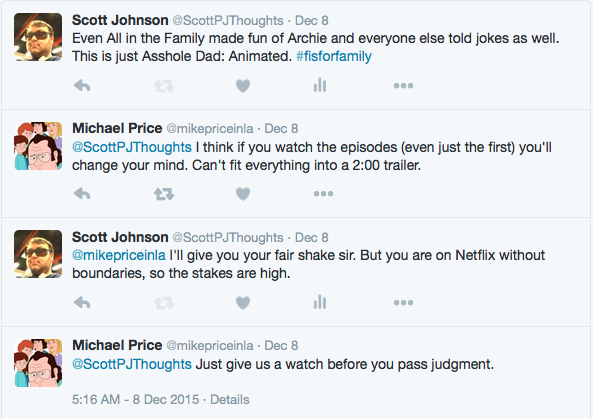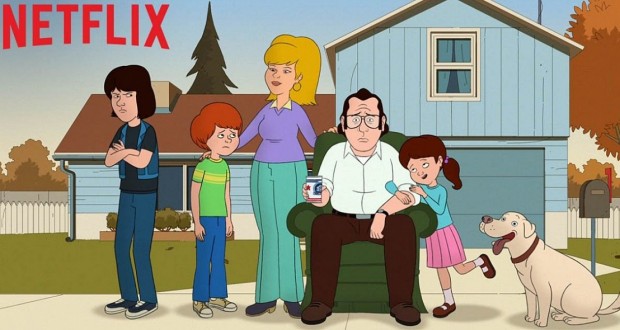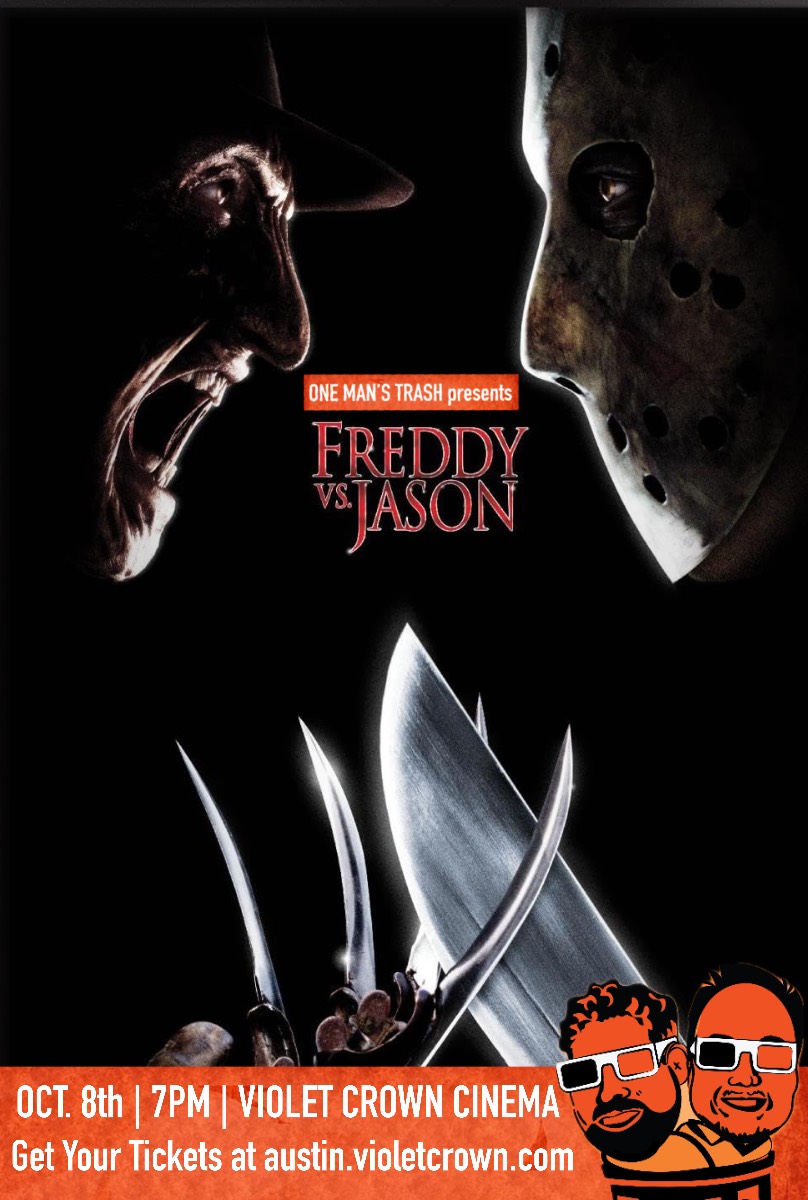As the festivities fade away, “Animated Anarchy” hopes to find fruition through Netflix’s new animated sitcom from Bill Burr and Michael Price, F is For Family!
There is no rest for the wicked and that couldn’t be truer for list making critics. Just as I’m ready to wrap up my articles about the best/worst cartoons of the year, there’s a blitz of endgame content that I have to keep up on. It can’t be stated enough that Netflix has some pretty amazing original content, but their animation slate is mostly a wasteland. I’m not talking Bojack Horseman, but take a peak at all the Dreamworks tie-ins or cheap CGI products like Dinotrux when you get the chance. You’d be shocked to see what awful, boring programs could only be found on Netflix; one of which is going to be my worst cartoon of the year.
F is For Family did not work for me with the opening trailer. I felt I was watching a pretty typical broken family sitcom that triumphs the reality of the good old days versus our modern inconveniences. It didn’t help many Youtube commenters of the trailer said people didn’t like the show because people are too politically correct, a subject that Bill Burr often criticizes. Yet people forget when offensive comedy is bad, it can be abysmally, painfully bad, which is how shows like Brickleberry come into existence. Seriously, I can’t wait for that day when people go “Man, you’re just too sensitive to deal with the radical, creative genius that is Rob Schneider.”
My curiosity was peaked when I reacted to the trailer on twitter, only to get a response from the co-creator Michael Price. I was pretty harsh on the initial sneak peak, since I didn’t laugh and I found people were praising it for simply being un-PC. Mr. Price suggested I watch the first episode instead of judging the show from the two-minute trailer. So with my Friday open due to the packed theaters, I could marathon through the short, 6-episode season of F is For Family.

F is For Family centers on the life of the Murphy clan set in the picturesque Northeast autumn of 1973. Frank, the head of the household, is constantly at odds with the world due to his sudden maturity from the military draft. He tries to stay sane for his supporting wife, but is constantly frustrated by his rebellious, mischievous children: Kevin, Bill and Maureen. How does one man keep it together with the world changing around him and his job constantly under the threat of strike?
By confidently using the voice of Bill Burr to create an unidealistic portrayal of blue-collar life, I can honestly say: Michael Price, you’ve done well.
I was genuinely surprised by how good F is For Family was. Not that it was a super funny show, but one I could appreciate because of how genuinely honest it was about the time period. I felt like the show wanted to break the mold of the typical American family, much like how Married with Children was reactionary to shows like The Cosby Show or Growing Pains. F is For Family manages to do this without going into canned, stale territory, unraveling a core of emotional depth similar to Freaks and Geeks.
The show does a great job by thoroughly layering Frank, who is that unapologetic, short-tempered type of dad suffocating under every type of periodic anxiety possible. The closest dad on TV I could compare him to would be Rick Foreman from That 70s Show, but replacing sarcastic threats with bits of impotent rage. Frank is a horrible and miserable person, yet we can understand how he’s so mentally strained from his circumstances. It’s very much the opposite of Bojack Horseman, which begs us to like someone who is so much more destructive and disconnected from reality.
The show manages to accomplish a lot within the short six-episode span; just about every character is given a fully explored arc. Frank is worried over his career at the nearby airport that’s under the threat of strike, while his wife Sue realizes how empty her life by only acting as a mother. The oldest son Kevin is a stoner flunkie, who is always fighting against his Frank’s bluntness towards his insecurities. Burr’s cipher, Bill, is also struggling with adolescence due to persistent bullies and he undergoes harsh experiences from the real world. Maureen isn’t given a whole lot to do sadly, but like Bill, she was very natural as a kid who had the chance to explore the neighborhood on a day-to-day basis.
Where I give the show the highest amount of praise is the way it subverts sitcom situations to have actual consequences. In Episode 4, “F is for Halloween,” Frank sabotages Sue’s attempt to get an actual job. In a normal sitcom, Sue would get angry but ultimately forgive Frank for being human and continue being the best homemaker she could be. In reality, Sue actually abandons Frank in the middle of Halloween, leaving him in shambles to take care of the kid. You get that genuine feeling of punishment, where Frank could cross the line by hitting someone or say the wrong thing that would destroy his home life.

Bill Burr is known for being an abrasive comedian, but you wouldn’t expect the amount of heart underneath his style of humor. Episode 3 is where the series hits into high gear when Kevin undergoes a minor breakdown while listening to one of his dad’s old vinyls. There’s a sincerity here shown throughout the animosity reminding us that the characters’ attitudes were alarmingly accurate for the time. If you decide to watch the series, you’ll go back and forth between laughing at the honesty or stunned at the level of potential trauma.
Michael Price on the other hand stands out as an animation veteran, who worked since the 90s on projects like Ahhh! Real Monsters, Hercules (the TV adaption of the animated film), The PJs, and The Simpsons. His history with The Simpsons has extended from 1996 to now shifting between roles of writer, editor, and executive producer. He’s written some pretty good episodes such as “Much Apu About Nothing” and “You Don’t Have To Live Like a Referee”, but he wrote one of the worst episodes of all time, “The Boys of Bummer.” His experience comes off pretty strongly here, as he keeps the show from devolving into rants by layering story and character progression.
What’s keeping a lot of people from checking the show out is the animation, which admittedly, isn’t too great. The style reminds me of a smoother, less amateur version of Stroker & Hoop as it doesn’t mind showing the ugly, slobby side of life. There aren’t many instances either indicating the show needed to be animated instead of live action. I’ve noticed several people compare this show to King of the Hill from the balance of slice-of-life realism mixed with occasional insanity, but the Massachusetts suburb is more universal and recognizable than the insular, dry wit in Texas.

F is for Family is the animation show Netflix needed. It highlights a talented comedian’s identity in a digestible, enjoyable way, while delivering strong small performances by Gary Cole, David Koechener, and Sam Rockwell. If you follow other cartoons, you’ll have fun poking out the number of characters voiced by Kevin Michael Richardson and Phil Hendrie (who most of us know as Principal Vagina from Rick and Morty) I can confidently say I’m excited for the next season, since the finale ends at a point making me worry for the future of the Murphy family.
My Arbitrary Rating for F is For Family Season 1: 7 out of 10 Cans of Plot Device Beer
Thanks for checking out this sudden Animated Anarchy. After get done watching a few more shows on Amazon Prime, I’ll be able to compose several of my “best of” lists for TV and Film. In the mean time, I hope you all had a great holiday and tell me what you would love to see for a possible article. Praise be to the Us!







